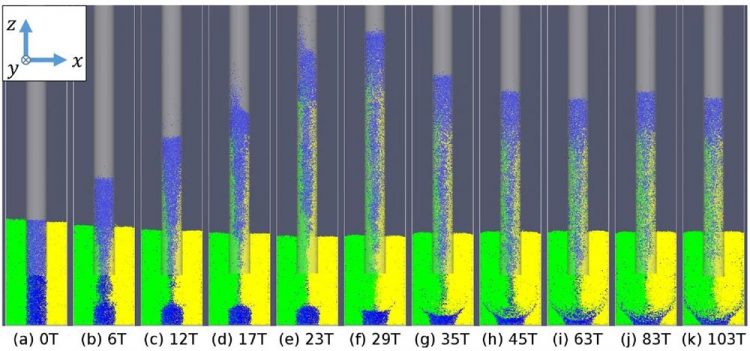Physicists discover mechanism behind granular capillary effect

When a narrow tube is dipped into granular material and vibrated vertically, the granular material rises inside the tube to reach a terminal vertical level. Credit: Fengxian Fan, Eric Parteli, Thorsten Pöschel
Dr Eric J. R. Parteli from the University of Cologne's Department of Geosciences, Professor Fengxian Fan from the University of Shanghai for Science and Technology, and Professor Thorsten Pöschel from Friedrich-Alexander University Erlangen-Nürnberg have now published the results of their study 'Origin of Granular Capillarity Revealed by Particle-Based Simulations' in the Physical Review Letters.
Liquid capillarity results from the interplay of different molecular forces: the attraction between the liquid molecules keeps it together while the attraction between molecules and tube drives the liquid upward. This explanation precludes the occurrence of capillarity for sand because sand grains are so much bigger than their constituent molecules that inter-molecular forces can be safely neglected compared to gravity and grain inertia.
However, surprisingly, granular capillarity has been observed in laboratory experiments in which the granular material was subjected to a tiny vertical vibration of a few grain diameters in amplitude and a frequency of just a few Hertz. The origin of this granular capillary effect was a long-standing mystery the international team of scientists succeed in unveiling.
They investigated the problem using a particle-based numerical simulation method called Discrete Element Method. In this method, the trajectory of every single grain is calculated by numerically solving Newton's equations of translational and rotational motion due to the forces that act on each grain. By means of such a numerical experiment, it is thus possible to track the trajectory and velocity of all grains, including those grains that are deep within the granular bulk, which are difficult to assess in the laboratory.
The research team observed in their simulations that what makes the sand column ascend in the tube is a convective motion of the sand grains within the recipient that is inherent to granular materials under vertical vibrations. This convective flux causes lateral mass transport within the vibrating granular packing, which leads to an upward pressure on the base of the granular column in the tube, which is why the column ascends.
The scientists found that how fast and far the column rises depends on the tube size. Remarkably, the simulations showed that the height of the granular meniscus (the capillary height that the granular column reaches after a long time) is proportional to the inverse of the tube size. This is exactly the same behaviour as for liquid capillarity, although the driving forces in the two systems are so much different.
The physicists showed in their study that the same capillary effect can be produced by shaking the tube instead of the container, which opens up promising applications in the handling and transportation sectors. For example, particles could be pumped up from very large containers just by using granular capillarity. They are now studying the process in more depth to understand the effect of system and particle geometry.
###
Publication: https:/
Media Contact
All latest news from the category: Physics and Astronomy
This area deals with the fundamental laws and building blocks of nature and how they interact, the properties and the behavior of matter, and research into space and time and their structures.
innovations-report provides in-depth reports and articles on subjects such as astrophysics, laser technologies, nuclear, quantum, particle and solid-state physics, nanotechnologies, planetary research and findings (Mars, Venus) and developments related to the Hubble Telescope.
Newest articles

Compact LCOS Microdisplay with Fast CMOS Backplane
…for High-Speed Light Modulation. Researchers from the Fraunhofer Institute for Photonic Microsystems IPMS, in collaboration with HOLOEYE Photonics AG, have developed a compact LCOS microdisplay with high refresh rates that…

New perspectives for material detection
CRC MARIE enters third funding period: A major success for terahertz research: Scientists at the University of Duisburg-Essen and the Ruhr University Bochum have been researching mobile material detection since…

CD Laboratory at TU Graz Researches New Semiconductor Materials
Using energy- and resource-saving methods, a research team at the Institute of Inorganic Chemistry at TU Graz aims to produce high-quality doped silicon layers for the electronics and solar industries….



